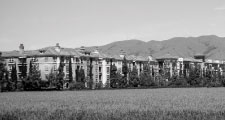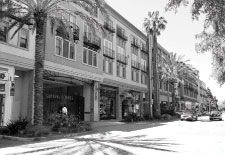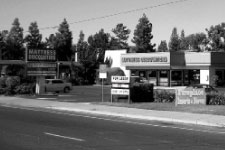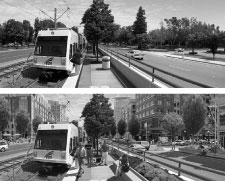Today, San Jose is the third largest city in California and the 10th largest city in the United States, with a population of just more than a million people, well in excess of San Francisco's population of nearly 800,000. In contrast to the political culture of San Francisco, in which every building is fought over and where population growth is modest, San Jose's willingness to grow is extraordinary.
From its origins as California's first urban settlement (founded in 1777 as the first Spanish pueblo), to its role as the first state capital in 1850, to a period as an agricultural market center for Santa Clara Valley (similar, perhaps, to Modesto or Merced), San Jose grew slowly for its first two centuries. Then after WWII, as Silicon Valley turned the South Bay into one of the great economic centers of the world, San Jose grew from 95,280 residents in 1950 to nearly 460,000 residents in 1970. Apricot orchards to the north gave way to research parks, and the Santa Clara Valley needed a city to house its growing middle class workforce.
Throughout the 1950s and 1960s, San Jose expanded aggressively by annexing large tracts of land. Dutch Hamann, the city manager from 1950 to 1969, led the annexation movement, vowing to make San Jose "the Los Angeles of the North."
The core of San Jose and its surrounding neighborhoods were laid out before the age of the automobile. It had a downtown, an urban street grid and other attributes of traditional town planning. In fact, San Francisco and San Jose had somewhat similar transit patterns until the 1910s, even though San Francisco was significantly more populous at that time. San Jose's downtown electric streetcar network was extensive, as was the Peninsula electric interurban trolley network that connected most of Santa Clara County.
But in the 1910s, the cities moved in opposite directions: At the same time San Franciscans were voting to tax themselves to purchase their city's privately operated transit lines and operate them as a municipal service, the Southern Pacific Railroad was acquiring San Jose's streetcar lines. As Southern Pacific's streetcars declined starting in the 1920s, three private bus operators worked to put Southern Pacific out of the passenger business. They too declined as cities increasingly oriented their land uses toward automobiles after World War II, leaving San Jose with no strong transit framework along which to orient development. San Francisco, meanwhile, continued to make major transit investments throughout the postwar era, allowing the older pedestrian fabric to persist. In other cities, including San Jose, much of it was destroyed.
Most of San Jose's growth occurred after the beginning of the age of the automobile. Residential areas in this age were developed without neighborhood shopping streets. The city grew as a series of disconnected "projects." Uses were segregated from one another. Today, the dilemma for San Jose is how to retrofit this suburban fabric—to make the city more walkable, to reduce emissions from driving and to accommodate the enormous growth that is still coming to the region.
San Jose is projected to add more growth within its limits than any other city in the Bay Area. If the environmental and social values of today were not enough to force a change to the planning context of the city, the need to accommodate this growth will certainly compel the city to take a new look at densities, land use mixes, parking requirements and all the other rules that govern new development.
San Jose's smart growth challenges
During the postwar years, San Jose grew outward rather than upward. It is now 174 square miles compared to San Francisco's 46. San Jose is not bound by water, and, in theory, could grow endlessly outward. However, an anti-growth reaction to the effects of rapid development emerged in the 1970s, ultimately leading to the adoption of an urban growth boundary at the base of the surrounding foothills. Then, in the 1990s, voters overwhelmingly approved a ballot measure designed to lock in the urban growth boundary and restrict development in the foothills.
As the culture of planning in America changed to embrace "smart growth" in the mid- to late 1980s, San Jose civic leaders began the long process of figuring out how to create a more "center-oriented," walkable place. San Jose built light-rail lines. It rezoned areas next to light-rail lines. Densities gradually increased. By 2007, nearly 80 percent of new housing in San Jose was built to be occupied by more than one family. And compared with more anti-growth communities, such as San Francisco, the housing in San Jose remained relatively affordable. San Jose also worked diligently to channel growth into its downtown, making the entire downtown a redevelopment area to facilitate the reinvestment of future tax growth in downtown infrastructure. The commitment to downtown was so great, in fact, that San Jose merged all its redevelopment areas into one area, allowing it to funnel most of the tax increment from North San Jose into downtown.
According to the Association of Bay Area Governments, San Jose is projected to add roughly 400,000 people and 340,000 jobs between 2010 and 2035. The City of San Jose has done its own analysis, projecting that it will add 471,000 people between now and 2040. In fact, San Jose is expected to add more housing and jobs than any city in the entire region. (Compare this to San Francisco, which is projected to add 159,000 people and 238,100 jobs by 2035).
The City of San Jose is doing a remarkable job of planning for this growth on the backbone of its growing transit network. But there are incredible challenges to creating walkable, transit-oriented neighborhoods in San Jose:
- Due to San Jose's rapid expansion in the postwar period, large swaths of the city are composed of auto-oriented, single-family subdivisions. The "bones" of these subdivisions resist retrofitting: There is no real street grid, no walkable mixture of uses and the parcels, having been subdivided, cannot easily be assembled for redevelopment at higher densities. It is not always possible to increase densities near transit. Instead, opportunities depend on a happy coincidence of uneconomic transit infrastructure—typically, underutilized commercial parcels that can be assembled for mixed-use development.
- Many of the major streets in San Jose are wide, auto-oriented arterials, and creating walkable neighborhoods would require major reconfigurations. Can the streets themselves be retrofitted when we know from our own experience in San Francisco that it often costs millions of dollars per block to widen sidewalks and put in street trees?
- The city has been able to attract substantial investment in new housing into its downtown, but has not been as successful attracting jobs there, with the notable exception of the Adobe headquarters. Areas such as North San Jose, Edenvale and Evergreen remain the employment centers—and, of course, Sunnyvale, Mountain View and Palo Alto continue to be significant employment locations for the broader region. Unless employment growth is redirected from these outlying locations, both in San Jose and around the region, San Jose's downtown will not emerge as a major employment center. Should the city keep trying, or should it treat its downtown as a residential core, more like Vancouver, British Columbia or San Diego—with the distinction that the city's job center of North San Jose is but a short street car ride away?
- Often, San Jose's neighborhoods with the best urban bones are older, prewar neighborhoods that are the least willing to accept new, denser growth. This dynamic is familiar to San Franciscans: Current residents of a neighborhood don't want it to change. The "pro-growth" attitudes of San Jose's civic leaders do not translate into a greater willingness of residents to tolerate physical change in their own neighborhoods.
- The success of Santana Row, a master-planned retail and residential development that emulates many traditional city design principles, competes with downtown. Santana Row is crowded with pedestrians in a way that downtown San Jose only experiences at night around key attractions. Again, San Jose is faced with the enormous challenge of creating a center when there are so many competing locations in the South Bay.
Boulevards and villages: a smarter growth pattern?
The City of San Jose is grappling with these challenges in an update to its General Plan now underway, organized under the name Envision San Jose 2040. The document proposes many of the ideas that constitute orthodoxy among progressive planners today: directing growth of both jobs and housing into "urban villages" and corridors. Urban villages are intended to include a mixture of uses and have a walkable and bikable urban form. Corridors will function like urban villages, in linear form.
The plan also calls for focusing on five "grand boulevards" as connectors among neighborhoods and places with their own unique identity, including North First Street and Monterey Highway; Capitol Avenue and Capitol Expressway; Alum Rock, Santa Clara and Alameda de las Pulgas and the San Carlos, Stevens Creek and Meridian corridors. The plan also asserts that every street in the city should be a "complete street"—no small order in a city with such an auto-oriented street network.
The work to be done to fulfill this vision is dizzying in scale and ambition. The "planned and identified growth areas" show an extensive network of proposed neighborhood villages and "transit areas." These areas are in addition to the specific plan areas and employment land areas, which are in varying stages of planning completion.
How will the city take its proposed growth targets, now overlaid on a series of neighborhoods and corridors, and ensure that the zoning and urban design controls produce the urban villages it seeks? How will the private sector react to the forward-thinking goals of the city? The answers to many of these questions are unclear, but two overarching strategies may help San Jose move closer to its vision for the future:
1. Investing in long-range planning to get the details right
Given the incredible amount of planning work it will take to get the details of each urban village and corridor right, the City of San Jose should invest resources in doing the planning and urban design work necessary to make these new places successful. This includes completing detailed zoning controls and design guidelines for each neighborhood and corridor in the planned and identified growth areas. Different areas and corridors may require different types of design guidelines in order to build on assets and address deficiencies. Moreover, public investment will need to be made in each of these areas in order to enable them to thrive. The City will need to create implementation plans and funding programs for each area. With the level of growth San Jose is projected to take on in the next 30 years, it will be critical that both planning work and infrastructure investments be funded. Where will these resources come from? At a minimum, the City should look at fee programs that allow it to recoup some costs from the beneficiaries of this planning.
2. Creating a constituency for good urbanism
Part of creating great cities is promoting great cities. One of the very special characteristics of San Francisco is the fact that almost every San Franciscan has an opinion about what makes the city wonderful. The city is constantly celebrating itself and its very San Francisco-ness. Through organizations such as 1stACT Silicon Valley, San Jose is starting to do the same. But more will be needed as the city grows up. The city should continue to incubate groups that promote urbanism—such as SPUR and Livable City in San Francisco, or Great City in Seattle. Additionally, the city can continue its efforts to sponsor public lectures by great urbanists such as Jan Gehl and Enrique Penalosa.

Much of greater San Jose includes swaths of car-oriented, single-family subdivisions—where increasing densities will prove difficult, if not impossible.
Since the 1970s, San Jose has billed itself as the "Capital of Silicon Valley." It's a good tag line, but San Jose is more than that. It is a highly diverse city with an increasingly lovely downtown, great natural resources and a burgeoning urban culture, as evidenced by events such as South First Fridays (arts and culture events in San Jose's SoFA arts district) and the San Jose Bike Party (a monthly group bike ride). Given that innovation clusters—(or what the older economists would call "industrial districts"—such as Silicon Valley don't last forever, we can expect that San Jose will be an important city after Silicon Valley is history.
The fact that San Jose is so ambitious about its growth, making enormous investments in transit infrastructure while beginning the long process of retrofitting its suburban fabric, is something unique in American urban history. We admire the vision, plans and effort our friends to the south are putting into the urban transformation of their city.



